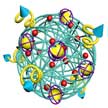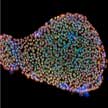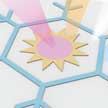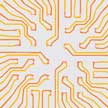Showing Spotlights 729 - 736 of 2879 in category All (newest first):
 Development of an effective approach for delivering a new drug is as important as inventing a new drug. Even if a developed new drug has excellent pharmacokinetic and therapeutic properties, it shows its potential activity in the body effectively only when it is exactly targeted to specific molecules. Various nanotechnological approaches for effective drug delivery have been developed and some of them have already been successfully commercialized. Most prominent nano drug delivery systems that are in market place are oncology related and based on liposomal, solid nanoparticle based, protein polymer conjugates and polymer-drug conjugate based delivery platforms.
Development of an effective approach for delivering a new drug is as important as inventing a new drug. Even if a developed new drug has excellent pharmacokinetic and therapeutic properties, it shows its potential activity in the body effectively only when it is exactly targeted to specific molecules. Various nanotechnological approaches for effective drug delivery have been developed and some of them have already been successfully commercialized. Most prominent nano drug delivery systems that are in market place are oncology related and based on liposomal, solid nanoparticle based, protein polymer conjugates and polymer-drug conjugate based delivery platforms.
Sep 18th, 2018
 Researchers have developed a way to achieve an ultra-high bioelectric signal from human embryonic stem cells using direct current-voltage measurements facilitated by few-layered 2D molybdenum disulfide sheets. This method, which produces cell signals 2 orders of magnitude higher than previous electrical-based detection methods, paves the way for the development of a broadly applicable, fast, and damage-free stem cell detection method capable of identifying pluripotency with virtually any complementary metal-oxide-semiconductor circuits.
Researchers have developed a way to achieve an ultra-high bioelectric signal from human embryonic stem cells using direct current-voltage measurements facilitated by few-layered 2D molybdenum disulfide sheets. This method, which produces cell signals 2 orders of magnitude higher than previous electrical-based detection methods, paves the way for the development of a broadly applicable, fast, and damage-free stem cell detection method capable of identifying pluripotency with virtually any complementary metal-oxide-semiconductor circuits.
Sep 17th, 2018
 Black phosphorus (BP or phosphorene), a novel two-dimensional semiconducting material, has gained tremendous attention because of its intriguing properties, such as ON/OFF ratio, high carrier mobility, and tunable direct band. However, a fundamental obstacle hindering practical applications is the lack of stability under ambient conditions. Now researchers demonstrated both excellent photoelectrochemical performance and significantly improved stability based on tin monosulfide nanosheets. These findings hold great potential for practical applications of phosphorene analogue nanomaterials-based devices.
Black phosphorus (BP or phosphorene), a novel two-dimensional semiconducting material, has gained tremendous attention because of its intriguing properties, such as ON/OFF ratio, high carrier mobility, and tunable direct band. However, a fundamental obstacle hindering practical applications is the lack of stability under ambient conditions. Now researchers demonstrated both excellent photoelectrochemical performance and significantly improved stability based on tin monosulfide nanosheets. These findings hold great potential for practical applications of phosphorene analogue nanomaterials-based devices.
Sep 13th, 2018
 Recently developed concepts in photonic designs and meta- and nanomaterials have improved the effectiveness of passive radiative coolers that function in the daytime. Whereas all of these radiative coolers are white or silver in color, researchers have now presented concepts and strategies for daytime radiative cooling systems that offer aesthetically desirable colors and patterns. These device not only emit infrared waves effectively under a clear sky, but also displays vivid colors.
Recently developed concepts in photonic designs and meta- and nanomaterials have improved the effectiveness of passive radiative coolers that function in the daytime. Whereas all of these radiative coolers are white or silver in color, researchers have now presented concepts and strategies for daytime radiative cooling systems that offer aesthetically desirable colors and patterns. These device not only emit infrared waves effectively under a clear sky, but also displays vivid colors.
Sep 6th, 2018
 The reorientation of elongated liquid crystalline molecules under the action of the applied electric field is a major physical effect enabling the use of liquid crystals in a variety of applications. To improve liquid crystal devices, new liquid crystal-forming materials are required. Recently, by merging liquid crystals and nanotechnology, a new, non-synthetic way to produce advanced liquid crystal materials was proposed. In short, it was achieved by dispersing various types of nanomaterials in liquid crystals.
The reorientation of elongated liquid crystalline molecules under the action of the applied electric field is a major physical effect enabling the use of liquid crystals in a variety of applications. To improve liquid crystal devices, new liquid crystal-forming materials are required. Recently, by merging liquid crystals and nanotechnology, a new, non-synthetic way to produce advanced liquid crystal materials was proposed. In short, it was achieved by dispersing various types of nanomaterials in liquid crystals.
Sep 4th, 2018
 Graphene bioelectronics has become a ground-breaking field that offers exciting opportunities for developing new kinds of sensors capable of establishing outstanding interfaces with soft tissue. Graphene-based transistors, as well as electrode arrays, have emerged as a special group of biosensors with their own peculiarities, advantages and drawbacks. A new review present sa comprehensive overview of the use of graphene for bioelectronics applications; specifically the focus is on interfacing graphene-based devices with electrogenic cells, such as cardiac and neuronal cells.
Graphene bioelectronics has become a ground-breaking field that offers exciting opportunities for developing new kinds of sensors capable of establishing outstanding interfaces with soft tissue. Graphene-based transistors, as well as electrode arrays, have emerged as a special group of biosensors with their own peculiarities, advantages and drawbacks. A new review present sa comprehensive overview of the use of graphene for bioelectronics applications; specifically the focus is on interfacing graphene-based devices with electrogenic cells, such as cardiac and neuronal cells.
Sep 3rd, 2018
 Nanotechnology researchers now have developed a natural and non-damaging hair surface engineering technique for making hair coloring formulations that do not use any chemical reactions but instead relies only on physical forces acting at a very close range. The same surface engineering approach is applicable to textile microfiber modifications because natural textiles like like wool, silk, cellulose, but also biomimetic synthetic textiles, have similar chemical composition.
Nanotechnology researchers now have developed a natural and non-damaging hair surface engineering technique for making hair coloring formulations that do not use any chemical reactions but instead relies only on physical forces acting at a very close range. The same surface engineering approach is applicable to textile microfiber modifications because natural textiles like like wool, silk, cellulose, but also biomimetic synthetic textiles, have similar chemical composition.
Aug 30th, 2018
 Achieving high-quality crystalline TiO2 films at room-temperature remains one of today's most important technical challenges toward low-cost optoelectronic devices including photovoltaic cells and photocatalytic device architectures. A research team has now demonstrated a simple method for triggering the crystallization of a TiO2 sol-gel precursor at low-energies. With this technique, it is now possible to achieve 90% crystallinity without metallic dopants, at room temperature and in ambient air, using low-power laser-induced photoactivation of an amorphous TiO2 nanoparticle film.
Achieving high-quality crystalline TiO2 films at room-temperature remains one of today's most important technical challenges toward low-cost optoelectronic devices including photovoltaic cells and photocatalytic device architectures. A research team has now demonstrated a simple method for triggering the crystallization of a TiO2 sol-gel precursor at low-energies. With this technique, it is now possible to achieve 90% crystallinity without metallic dopants, at room temperature and in ambient air, using low-power laser-induced photoactivation of an amorphous TiO2 nanoparticle film.
Aug 23rd, 2018
 Development of an effective approach for delivering a new drug is as important as inventing a new drug. Even if a developed new drug has excellent pharmacokinetic and therapeutic properties, it shows its potential activity in the body effectively only when it is exactly targeted to specific molecules. Various nanotechnological approaches for effective drug delivery have been developed and some of them have already been successfully commercialized. Most prominent nano drug delivery systems that are in market place are oncology related and based on liposomal, solid nanoparticle based, protein polymer conjugates and polymer-drug conjugate based delivery platforms.
Development of an effective approach for delivering a new drug is as important as inventing a new drug. Even if a developed new drug has excellent pharmacokinetic and therapeutic properties, it shows its potential activity in the body effectively only when it is exactly targeted to specific molecules. Various nanotechnological approaches for effective drug delivery have been developed and some of them have already been successfully commercialized. Most prominent nano drug delivery systems that are in market place are oncology related and based on liposomal, solid nanoparticle based, protein polymer conjugates and polymer-drug conjugate based delivery platforms. 
 Subscribe to our Nanotechnology Spotlight feed
Subscribe to our Nanotechnology Spotlight feed





